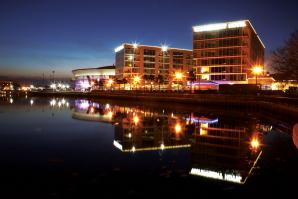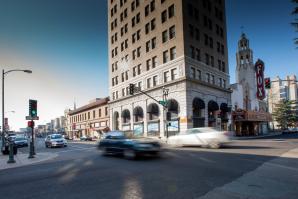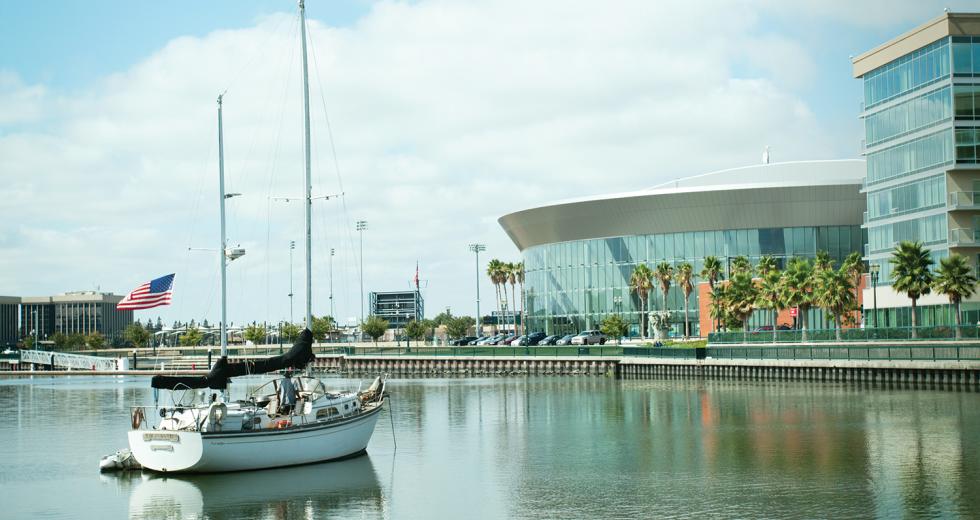If you think starting a business during a recession is a risky enterprise, imagine putting your entrepreneurial faith in the commercial future of a river flowing to a desolate wilderness.
That’s exactly what California pioneer Charles Weber did.
Arriving here prior to the California Gold Rush with a land grant in his pocket, Weber saw possibilities. A German immigrant and California opportunist, Weber imagined the San Joaquin River flowing to an inland port at the head of the Stockton channel. If a port could be established, he reasoned, its commerce would grow a city.
The story of Stockton begins with that vision. And when news of gold discoveries brought the world to the port of San Francisco — and from there to the travel hub and mining supply center of Stockton — Weber was sitting pretty. The bustling port lost no time growing into a community of which Weber was owner, designer and benefactor.
Today, Stockton is once more looking to its river channel — again with the hope of becoming a destination city. A new $26 million marina anchors the enterprise and complements shoreline attractions such as the Stockton Arena, Banner Island Ballpark and the Lexington Plaza Waterfront Hotel.
Opened in late 2009, the marina takes advantage of Stockton’s greatest natural asset, drawing boaters to docks and providing recreational opportunities for strollers, picnickers and joggers along the 1.7 mile-long Joan Darrah Promenade.
Bill Williams, owner of OSC Computer Training at the south shore Waterfront Warehouse, can see his 40-foot yacht from the windows of his office.
“I’m quite impressed with the marina,” says Williams, who cited the beauty of the area and its relaxing, soothing atmosphere. “Everything’s been done in a very top-notch way here. It’s something Stockton should be quite proud of, and it positions the city well for when the economy turns around.”
“It’s nice to be able to dock your boat and walk a few hundred feet to a baseball or hockey game,” says local boater Roger Kelly, former commodore of the Sea Ray Boat Club of Northern California.
“It’s not a finished project, but it will help Stockton blossom,” Kelly says. Business analysts agree, pointing to a direct economic benefit from the project’s enticement of boaters and other visitors and the potential it offers for retail and residential development.
“It makes the area more attractive and increases the appeal of it, which in turn can drive economic development in the greater downtown,” says Jeff Michael, director of University of the Pacific’s Business Forecasting Center. “Stockton needs to emphasize its connection to the water and make that more of the city’s identity. It’s a big part of what makes us unique. Stockton is a water city, but a lot of people don’t realize that.”
A lot more people will realize it when the city’s Asparagus Festival opens next month at the Weber Point Events Center, once the site of Weber’s landmark two-story house and extensive gardens. Long gone, the memory of the Weber house lingers on, an inspiration for Stockton’s first settlers and a paradigm of riverside development. Some say the city missed a marketing opportunity by not adding a replica of Weber’s pioneer home or Gold Rush museum to the waterfront plan.
The marina encompasses 7.5 acres of landside improvements, including a promenade, plazas and parks, and 2.5 acres of waterside improvements such as 66 berths and 1,400 linear feet of guest docks that can accommodate up to 110 boats.
Funded by $11.2 million in federal grants and loans and $14.8 million in state grants and loans, the marina marks a decade of construction and progress that began with the events center in 2000 and Dean DeCarli Waterfront Square the following year. One of the most unusual and controversial proposals not approved by the city called for the acquisition and mooring of the historic battleship USS Iowa at Rough & Ready Island (just beyond the Port of Stockton) as a permanent water display. Conversion expense and maintenance costs, plus fear that the battleship might turn into an economic white elephant, were determining factors for abandoning the scheme. The Port of Los Angeles and Mare Island in Vallejo are currently competing for the ship.
“If done right, there were real possibilities for it being a draw and making Stockton a destination point,” says Douglass Wilhoit Jr., CEO of the Greater Stockton Chamber of Commerce. Even without a 45,000-ton battleship as its mascot, the marina project has managed to draw attention to the city, upgrade its image and bring new traffic to downtown sports, restaurant and entertainment venues.
“It’s bringing people to downtown Stockton who normally wouldn’t come,” says Marina Manager and Harbormaster Sherri Keys. “They go on from here to a baseball or hockey game, a movie at the cineplex or a show at the Bob Hope Theatre, a meal at Misaki or Chitiva’s, and then they come back and say, ‘Wow, this is a wonderful place. I didn’t know there was so much to do downtown.’”
More than just a scenic backdrop, the marina is the front door of the downtown from the waterway and an anchor for revitalizing it, says Deputy City Manager Mike Locke. “It creates an important identity point — a sense of place — for the community.”
As the economy improves and investment returns, Locke and others foresee investors drawn to opportunities along and beyond the marina. Water taxis could connect north and south shores. Add restaurants, shops, kayak and canoe rentals, fish and chips, condos and apartments, and fishing and racing events arranged by the city’s sports commission.
“The Delta is one of the most impressive ecosystems in the world and one of the richest agricultural areas in the world,” says City Councilmember Susan Talamantes Eggman. “‘People are becoming much more interested in how and where their food is grown. Connecting the marina to the Delta could help them understand their relationship to food and connect with it in a much more personal way.”
Despite the economic downturn, the mood is upbeat when it comes to untapped possibilities. Whatever its direction, the marina has laid the foundation for confidence and future growth.
“2010 was our first full season, but we saw how the design of the marina attracted wide attention and an unexpectedly large number of users,” says Redevelopment Program Manager Erin Mettler. “We saw an overlap of visitors staying during events like the Asparagus Festival and Fourth of July, as well as yacht clubs coming in for long weekends and leaving their boats to connect with downtown restaurants and theaters.”
With additional funding, future projects could include extending the promenade another 2.5 miles to connect with Louis Park and enticing a restaurant or two to the vacant parcel fronting the water near the Stockton Arena. Cultivating the Delta connection to food and history envisioned by Eggman could advance the city’s potential market for tourism.
Progress so far has helped turn the once-blighted and neglected waterfront into an attractive entry into Stockton and a shining example of city renewal that welcomes new arrivals.
“The initial image of the waterfront tells visitors we value our resources and celebrate our community,” Mettler says.
That wouldn’t have surprised Charles Weber in the least. Long ago, he looked at a waterway and saw opportunity. The city he founded is still doing just that.
Recommended For You

Waterfront Shack-Up
Students move in at Stockton's premier hotel
Forget books, exams and professors. The campus buzz at Stockton’s University of the Pacific is about the hottest new idea in off-campus housing: Lofts at the University Plaza Waterfront Hotel.

Slouching Toward Genesis
As reconstruction begins, Stockton searches for itself
Since filing for bankruptcy last year, Stockton hasn’t seen any immediate improvement. The city ended the year with 71 murders, a steady climb from only 26 in 2009. The rise has been attributed to a shrinking police force after the city slashed the department’s budget.



